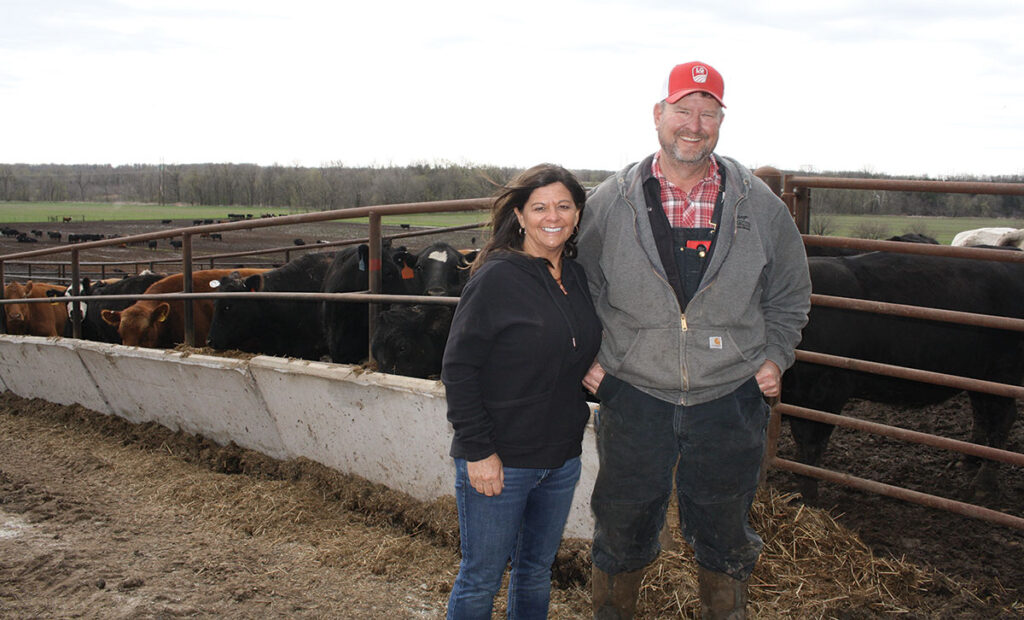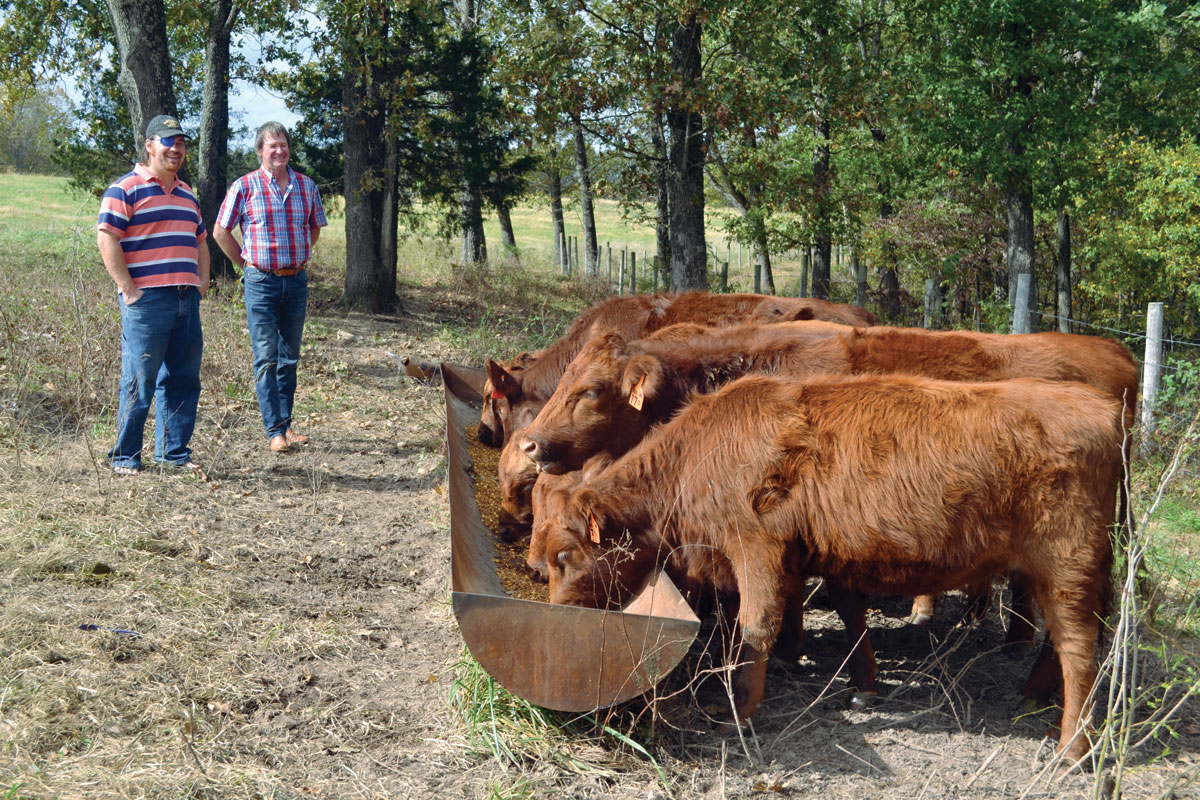
Aaron and Teresa Johnson utilize facilities once used to house and feed dairy cattle for their cattle feeding operation. Photo by Julie Turner-Crawford.
Aaron and Teresa Johnson go from a dairy operation to feeder cattle
PLEASANT HOPE, MO. – After decades in the dairy industry, Aaron and Teresa Johnson decided in 1993 that it was time to make a change, but they still wanted to remain in the cattle industry. Taking advantage of the facilities they had in place for the dairy cows, they began a feeder operation.
ATS Farms, named for Aaron, Teresa, and their daughters Shayna and Shyann, now has close to 1,000 head of contracted and owned cattle on feed.
“My land isn’t set up for a cow/calf operation,” Aaron explained. “We don’t have much pasture ground. Our farm is river bottom, so we are a little different than anyone else around here because we can grow a lot of feed, but we don’t have the pasture.”
Because they don’t produce their own calves, the Johnsons seek out cattle from reputable Missouri farms for their finishing operation.
“I like to buy my calves between 750 and 900 pounds,” Aaron explained. “I buy my cattle from someone who has some history behind them and background. I don’t try to put together calves; I’ve done that in the past, and it doesn’t work.”
He buys calves only from reputable producers who can verify birth dates, health and origin.
“I want the track record of those calves,” Aaron said. “I want to know if they had their shots, the last time they were wormed, and anything they might need. That way, we have the whole history of the calves.”
“He’s very picky about the quality of the cattle we bring in,” Teresa said.
The Johnsons typically purchase 200 to 300 head at a time and feed them until they reach 1,500 to 1,600 pounds. Thirty to 45 finished animals are sent Missouri Prime Beef Packers at a time.
“It would be fantastic to do a load every month, but with our pens and barn, it’s not realistic,” Aaron said.
Previously, the Johnsons purchased cattle at about 550 to 600 pounds, feeding them until they hit the 850- to 900-pound mark.
“We were leaving a lot of money on the table,” Aaron said. “That 750 to 850 mark is the easiest time to have the cattle. Back then, we bought Draxxin by the case. Now, it’s the exact opposite; I don’t even know where the bottle of Draxxin even is. There are 255 head that have been here since October, others that came in January, and there’s not one single calf that has had a shot, and we have had zero death loss. Those fats we are getting ready to sell will likely make us more money than any cattle we have ever had on this farm.”
Brangus and crossbreeds are the Johnsons’ preference for their feeder cattle.
“They out gain a straight Angus two to one,” he said, adding he prefers steers over heifers. “We feed pretty hard, too. It’s like milking; you can starve the milk out of your cow or feed the milk out of her. The calves will only perform how you make them perform.”
Calves finished at the farm are housed in a large pen pack barn, about 147-feet wide and147-feet long.
“They are all on concrete,” Aaron said. “There is zero runoff because we clean the feed alleys every day and haul that manure down to the cropland. With fertilizer prices, that’s a plus. The cattle lay on cornstalks, and those also get spread back onto the fields.”
The use of manure on cropland, he added, is a critical component of healthy, fertile soil.
“We ran a soil test in front of the planter a couple of years ago,” he recalled. “With no fertilizer, we have 110 pounds of nitrogen per acre for the corn, all from cow manure. We grew up hauling manure every day. My dad and grandpa never unhooked the manure spreader from the tractor it was on.”
Bedding, which is also produced on the farm, is only cleaned from the barn once a year, but additional stocks are added as needed.
“I wouldn’t feed calves outside again,” Aaron said. “The health of the cattle is much better. When we have that wet, cold, drizzling rain, and it’s 32 degrees, the cattle are inside smiling. In the summer, it’s 20 degrees cooler in the barn than outside. We built the barn in 1993, and people had the concept that confining cattle was hard on them. When we run cattle out to clean the feed alley, it takes two to three people to get them out, and then when you get the alley clean, you just have to open the gate and jump on the fence; they fly back in there. You can open a gate, and they won’t walk out.”
The Johnsons grow the corn and silage fed to cattle at ATS Farm.
“I mainly feed corn and distillers,” Aaron said, adding that cattle also receive about 1.5 percent Feedlot Balancer vitamin and mineral in their ration, with each calf receiving 30 to 50 pounds per day. “We plant a little over 1,000 acres of corn, milo and beans, and some of that is custom and crop shared. For us, it’s huge to be able to grow our feed because it fits our niche. Is it right for everyone? No, but it works for us.”
Feeding cattle instead of grazing may seem more expensive, but it is the best option for Aaron and Teresa’s operation.
“For my bigger calves, it’s costing me $5 a day, but they are putting on between 4 and 5 pounds a day. It’s not what it costs to feed them; it’s what it costs per pound to gain. Some guys say corn is too high to feed; it isn’t. For the return on your investment, nothing replaces corn. Where’s that line at? I can’t answer that, but the nutritionist has backed the corn off on my growing calves but increased the distillers. Our corn silage is also pretty hot because we were chopping 180-bushel corn. If we had just fescue hay, it would be a big difference.”
ATS Farms is part of the Missouri Prime Show Me Beef program, which the Johnsons believe adds value to their cattle and offered consumers a locally-produced product.
“Our picture is at Price Cutters and so is our meat,” Aaron said with a smile. “Missouri beef is at places like the Metropolitan Grill and others; it’s nice to know that.”
Aaron and Teresa admitted they were skeptical about Missouri Prime before it came to Pleasant Hope, but they are proud to be partners with the packer.
“They contacted me about a year before them ever coming around,” Aaron said. “I wanted something that would be here for the long hall. There were a lot of people in and out of (the facility) before they came in. Missouri Prime is here to stay. There used to be this mindset that you couldn’t feed cattle in Southwest Missouri. Well, that’s not true. There’s more corn grown down here that there used to be, too, and you have the demand.”
Additionally, ATS Farms houses cattle, short-term, for Missouri Prime Beef Packers, which is only a couple of miles away from their Pleasant Hope, Mo., farm.
Aaron is the fourth generation of his family on his farm and feels there needs to be more to keep the agriculture industry moving forward in the area.
“We have to get something sustained for the next generation,” Aaron said, adding that Missouri Prime and NextGen Beef Company, which owns Missouri Prime, have similar goals. “Missouri Prime has given this part of the country a huge opportunity and another avenue, not just for fat cattle, but they kill cows too. It’s amazing the money that has been taken out of here for years.”
“Promoting Missouri beef is keeping our product and money here,” Teresa said. “People want to support local, and this has afforded us this opportunity.”







